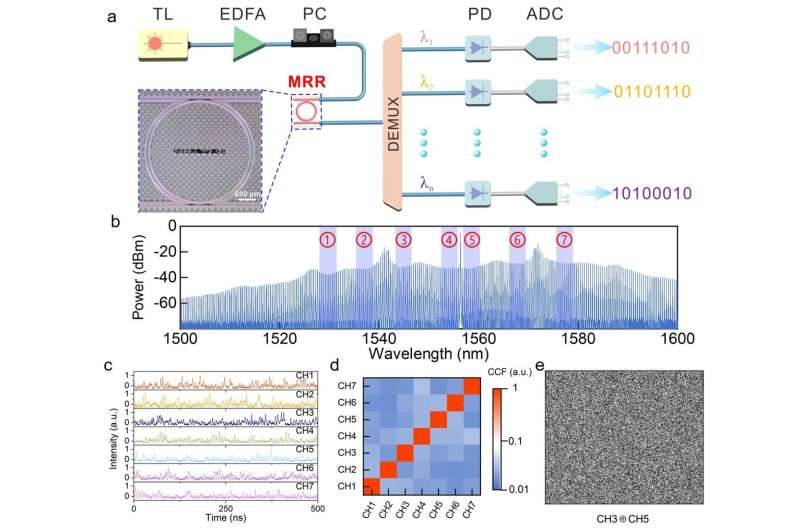This article has been reviewed according to Science X's editorial process and policies. Editors have highlighted the following attributes while ensuring the content's credibility:
fact-checked
trusted source
proofread
Parallel physical random bit generation towards rates of order 100 Tb/s

In our digital networked society, random bit generators (RBGs) are vital for services and state-of-the-art technologies such as cryptographically secured communication, blockchain technologies, and quantum key distribution. An ever-increasing demand to improve the security of digital information has shifted the generation of random bits from sole reliance on pseudorandom algorithms to the use of physical entropy sources.
Shannon's theorem establishes that it is required for the ultimate security to achieve bit rate matching that of the true RBGs with that of the communication systems. For this purpose, optical chaos has been widely studied in the past decades as a means for the generation of broadband entropy sources to overcome the bit-rate bottleneck of traditional electronic RBGs.
However, speed and scalability are key challenges faced by current physical random bit generation. Because such chaotic sources usually produce just one channel of non-correlated stochastic intensity fluctuation, only one random bit stream can be generated for most available optical-chaos-based RBGs.
Limited by the response speed of entropy extractors such as analog-to-digital converters (ADCs), it is very challenging for such sequential methods to continually improve their random bit generation rate so as to meet the ever-growing demands of advanced communication systems.
In a paper published in Light: Science & Applications, a team of scientists, led by Professor Pu Li and Yuncai Wang from Institute of Advanced Photonics Technology, School of Information Engineering, Guangdong University of Technology, China, and co-workers have proposed a scalable parallel scheme for ultrafast random bit generation towards rates of order 100 Tb/s based on a single micro-ring resonator (MRR).
A modulation-instability-driven chaotic comb in a micro-ring resonator enables the simultaneous generation of hundreds of independent and unbiased random bit streams.
A proof-of-concept experiment demonstrates that using this method, an ultrafast parallel physical RBG with a single chaotic microcomb can reach a 320 Gb/s generation rate per channel, and hence a total bit rate of 2.24 Tb/s can be obtained by only using seven channels. This bit rate can be easily enhanced by further increasing the number of comb lines used.
Compared to existing RBG schemes, this method with a single MRR has a massive scalability and extremely high efficiency. It not only can produce hundreds of independent parallel random bit streams, but it also can greatly enhance the generation rate in a single channel.
In addition to the ultrahigh speed, this method commends itself for its simplicity and scope for generalization. Without using any special materials, the chaotic microcomb in their experiment is produced by a CMOS-compatible, high-index, doped silica-glass MRR.
More importantly, both the ultra-small size of the MRR and the simplified random bit extraction means that this method is amenable to chip-scale parallel RBGs.
More information: Pu Li et al, Scalable parallel ultrafast optical random bit generation based on a single chaotic microcomb, Light: Science & Applications (2024). DOI: 10.1038/s41377-024-01411-7

















